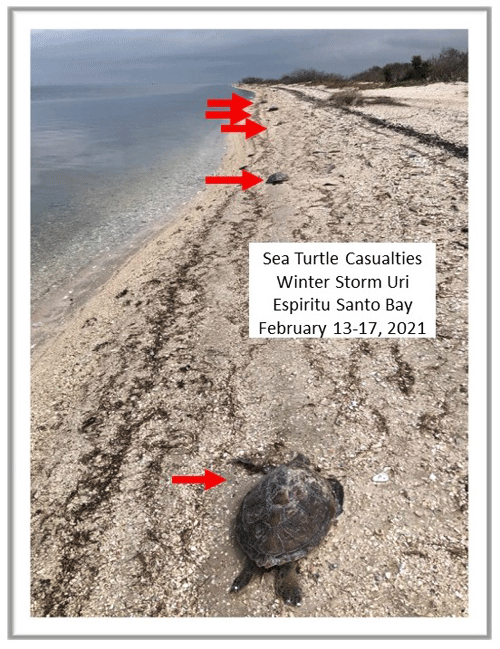 As I walked along small island shorelines in Espiritu Santo Bay removing derelict crab traps during the official closure period, dead animals littered the ground, casualties of Winter Storm Uri the week before. Temperatures not only dropped well below freezing but stayed there for days, too long for many of these warm water species.
As I walked along small island shorelines in Espiritu Santo Bay removing derelict crab traps during the official closure period, dead animals littered the ground, casualties of Winter Storm Uri the week before. Temperatures not only dropped well below freezing but stayed there for days, too long for many of these warm water species.
Texas Parks & Wildlife had blasted a request to the public and groups like the Texas Master Naturalists to help document the event using the iNaturalist app tagging their project “Winter Storm Uri Wildlife Deaths”. Across the state, people were taking photos of various species killed by the fridge temperatures. So, as I walked along I took photos of dead mullet, catfish, gaff top, sheepshead, trout, & redfish and many not so commonly seen species too. Cow-nose rays, bull shark, black drum and a palm-sized soul called a hogchoker, burrfish or puffer fish, decorator crabs, and needlefish and smaller bait fish like crocker and piggy perch. The most unusual was a 4 foot long Stipple spoon-nose eel.
Saddest of all, however, were the sea turtles. One right after another. Some of them laying together as if they died trying to stay warm together (but likely was a result of the winds & currents). I had no idea there were this many green sea turtles in our waters. The greens are widely spread across the world’s tropical waters. Their major nesting is in Costa Rica, Australia, and Oman. The US has smaller nesting sites in Florida, Hawaii and Puerto Rico. According to James Spotila in his book Sea Turtles, “At 15 – 24 inches they move into shallow areas with seagrass beds.” The green is the only sea turtle who eats large amounts of plants, primarily seagrasses and algae.
In the days following Uri, I read of the agencies and volunteers who rescued thousands of cold-stunned turtles both north and south of here. Unfortunately, the middle coast is lacking in that type of wildlife support. The least that could be done was to get some sense of the damage and document it. So, I returned to a small stretch of shoreline along Vanderveer Island which forms the outer edge of Pringle Lake. In just 2.25 miles, I measured and photographed 139 dead green sea turtles, ranging from 12.8 inches to 30.6 inches. Interestingly, eleven of them (8%) were over the 24-inch size that Spotila mentions. These represent just a small sample of dead turtles along the mid-coast. My hope is that enough survive to replenish the bay.
How can you help? Reduce your speed and elevate your propeller when going through shallow grass flats where turtles feed. Report sea turtle sightings in Matagorda Bay using the iSea Turtle app on your phone. For turtle deaths or strandings call 1-866TURTLES5 (1-866-887-8537). Keep our waters litter free by securing items on your boat and reduce your use of single use plastics, like bags and water bottles.
Brigid Berger, Texas Master Naturalist
